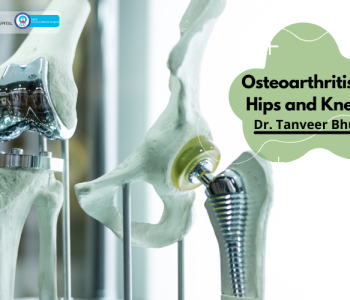 Eva Hospital
Eva Hospital
Osteoarthritis of Hips and Knees
Arthritis is one of the most common chronic problems affecting majorly patients over the age of 70 but it may affect younger people too.
The severity of osteoarthritis increases with age. The most common joint affected in osteoarthritis is the knees, hands, and hips.
A degenerative type of arthritis called Osteoarthritis occurs mostly in people above 50 years of age though it may occur in younger people too.
Introduction
Our joints go through a normal cycle of wear, tear and repair during our lifetime. As the joints repair themselves, their shape and structure change. If this change happens in one or more of your joints, it is called Osteoarthritis.
The part of the human body where two or more bones meet is called a joint. A common condition, Osteoarthritis can affect any joint but it mostly affects the joints that bear most of our weight, such as the hips & knees.
A healthy joint has no damage to the bone, cartilage or synovium. A coating of tough, smooth & slippery tissue, which covers the surface of the bones aiding them to move freely against each other is called the Cartilage.
But when a joint develops osteoarthritis, part of this cartilage becomes thin making the surface rougher, hindering the smooth movement of the joint.
As the cartilage is worn or damaged, the tissues within the joint become more active than normal as a result of the body trying to repair the damage.
This changes the structure of the joint, but the joint can still work normally without any pain & stiffness. Most people develop Osteoarthritis in some of their joints with age, though we may not even be aware of it.
Osteoarthritis causes the thinning of the cartilage in the knee and hip joints making the surface rougher, causing swelling, pain & stiffness of joints in many people.
Causes of Osteoarthritis
The risk of developing osteoarthritis depends on several factors mainly being the Age. It usually starts from the late 40s.
This can be attributed to bodily changes such as weakening of muscles, weight gain, and the body losing its capacity to heal itself effectively.
The other causes of joint damage may include a past injury such as torn cartilage, dislocated joints, ligament injuries.
Joint malformation, obesity, changing weather, and poor posture can also be the reason for Osteoarthritis. Family history and gender can also play a role in increasing your risk of Osteoarthritis.
Read more: Difference between Osteoarthritis & Rheumatoid Arthritis
Symptoms
The Symptoms of Osteoarthritis may vary from person to person depending on their routine.
Pain, tenderness, and stiffness in the affected joints is the main symptom of Osteoarthritis. The pain that worsens on the movement of the joint or the joints that feel stiff after rest can be a sign of Osteoarthritis. They might get swollen, hard and knobbly.
The free and normal movement may be hampered and it might make a grating or crackling sound on movement. As the disease advances, the pain may become more intense.
Treatment
Improving the person’s mobility and lifestyle is the main motive of treating Osteoarthritis. The prime focus is given to the functioning of the hip and knee joints and controlling pain.
Rest and joint care, use of a cane to help take the weight off the affected joint, pain relief techniques, weight loss, and exercise are also recommended.
Medications like acetaminophen (Tylenol), an nonsteroidal anti-inflammatory drug such as ibuprofen etc are sometimes used to manage pain.
Sometimes Surgeries, Complementary and alternative therapies are also put to use to manage the condition.
Types of Surgeries
Arthroscopic Surgery
The surgeon inserts a thin tube with a tiny camera attached on its end through a small opening in your skin to examine the inside of your knee.
He then removes the damaged cartilage. The knee can be also cleaned to remove loose bone or cartilage pieces that are causing pain.
One can resume usual activities a few days later. Arthroscopic surgery provides short-term relief from pain and delays more complex surgery.
Joint Replacement Surgery
When all the osteoarthritis treatment options have failed, it is often advisable to opt for Joint Replacement Surgery.
It helps reduce pain and improve the ability to move the affected joint. The Joint (Hip or Knee) replacement surgery involves removal of all or part of the knee joint and replacing it with an artificial joint, made of metals and plastics.
This kind of surgery done by a competent surgeon has a very high success rate and can help the person to live a pain-free life.
Overview
Osteoarthritis is a painful condition that can hinder the normal movement and lifestyle of the person. It can be managed and treated by a competent Orthopaedic & Joint Replacement Surgery is a novel way of treating the condition, with a high success rate.
About the Doctor
Dr. Tanveer Bhutani is a very renowned Orthopaedic Joint Replacement Surgeon with vast experience in treating the Osteoarthritis of the Hips and Knees. To book an appointment